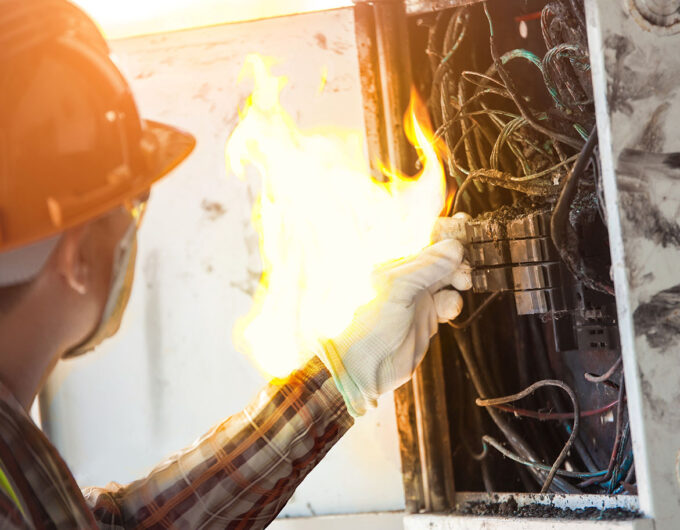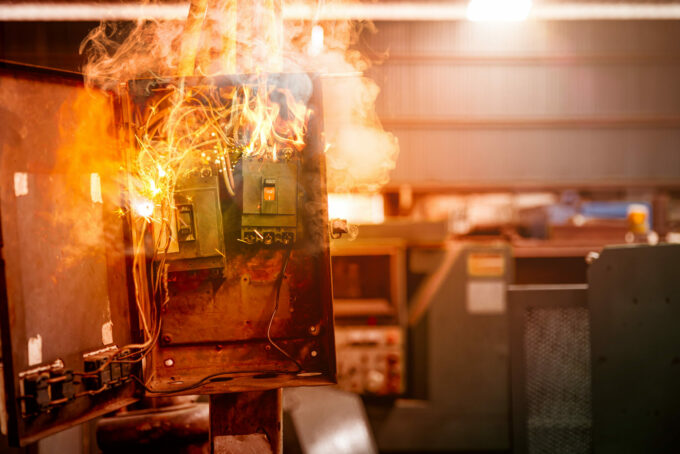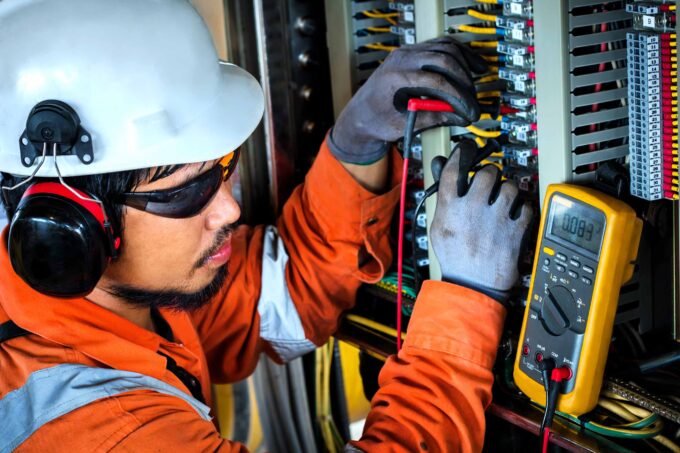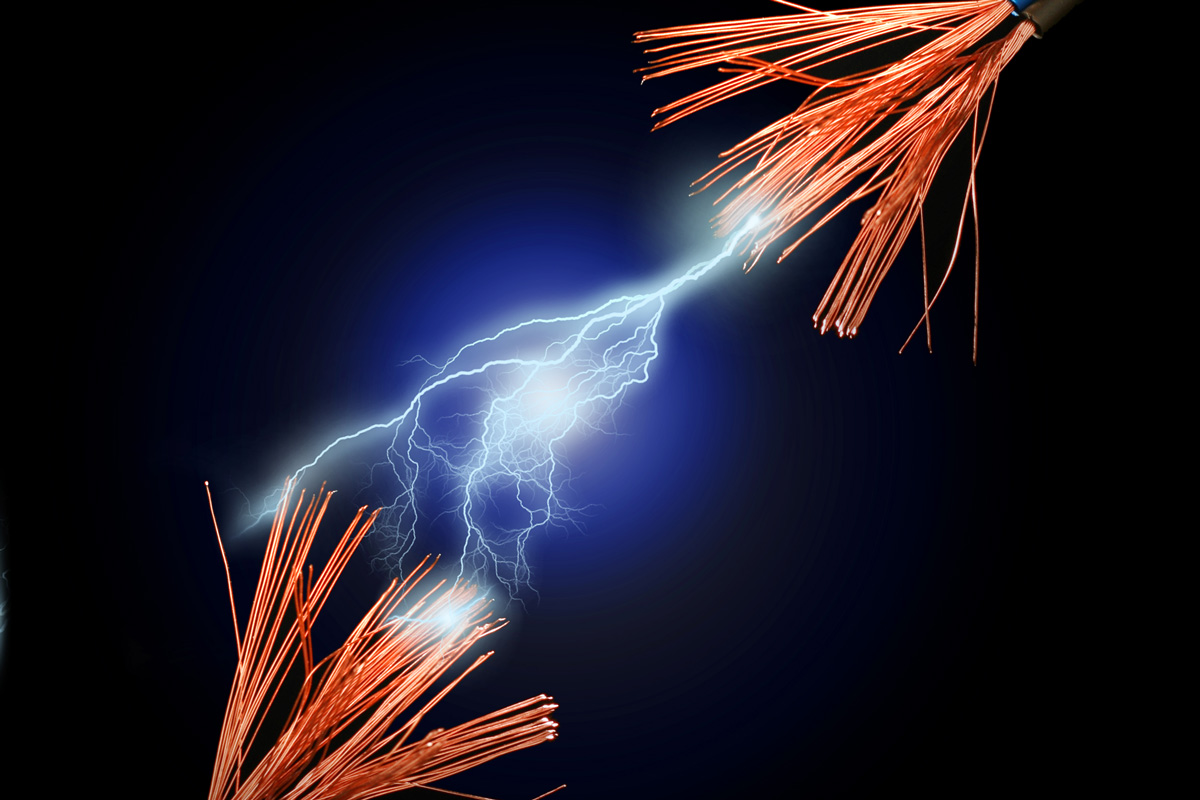An electrical arc flash occurs when an electric current leaves its intended path. This can happen with any amount of voltage, and naturally, the danger only increases with the amount of electricity.
Instead of being transferred from one phase to another phase, a conductive force gets in the way of the circuit. Frayed wires, conductive material near the circuit, or accidentally dropping tools in the area are common ways that this can happen.
An electrical arc flash can pose a significant danger to your workers and anyone in the vicinity. It is crucial to have proper training when working in dangerous electrical environments. The minor risks associated with arc flashes should be taken seriously, and the major risks could result in life-threatening injuries.
Effects Of Arc Flashes
Arc flashes result in a burst of electricity and heat. An arc flash is measured by the amount of heat energy the explosion makes. The combination of heat and rapid expansion can cause toxic metals to vaporize, causing additional danger.
Fire is also a potential risk if the blast happens near flammable materials. The amount of heat generated from an arc flash can be intensely hot, enough to melt metal. Being outside of the initial blast zone doesn’t guarantee your safety.
Facility Results damage can be costly to recover. In adoption to the malfunctioning machinery, resulting electrical and fire damage will need to be tended to, as well as the proper inspections before the project can resume.
Potential legal issues that arise due to the accident can be time-consuming and costly. The most catastrophic damage, the loss of your life, can quickly become the beginning of a long nightmare if the proper care isn’t taken on the job.

Medical Complications
The risk of injury during an electrical arc flash is significant. Being involved in an arc flash can lead to electrocution, irregular heart rhythm, and topical injuries such as burns and possible abrasion from displaced materials.
Central nervous complications and stroke are also significant risks. Immediate medical attention is necessary when an arc flash occurs, even if the blast appears to be small in size. The risk for additional medical complications is exponential if not tended to as soon as possible.
Other possible injuries include hearing loss from the initial blast or possible blindness from the electromagnetic flash. The intense light from the flash can cause temporary or even permanent retinal damage.
Inhalation of toxic fumes can lead to immediate and lasting respiratory issues. This can cause permanent damage to the lungs. Once I hailed, trace amounts of toxic metals can enter the bloodstream, thus poisoning the individual involved in the accident. Arc flash injuries should all be treated with the utmost severity.
Types of Arc Flashes
A tracking arc ─ typically occurs at higher voltages. This is when arc plasma conducts through the clothes or comes into direct contact with the skin. This is a more common type of arc flash. Open air arcs: happen when ionized air in the blast zone becomes molten, turning it into a plasma that is incredibly dangerous. Ejected Arcs: are when arc plasma hits a worker. All of the above-listed types of arc flashes are dangerous and can result in fatal side effects.
There are some subtle differences between the different types of arc flashes but the danger is ever present in each form. Whether you have direct or indirect contact with the arc, the resulting damage can be life-threatening. Try searching online to learn more about electrical arc flash situations and the problems they can cause.

Arc Flash Safety
There are many ways to protect workers from the dangers of an electrical arc flash. Personal Protective Equipment (PPE) such as suits, helmets, boots, and gloves can be used when working in the area. It is important to be sure that the PPE being used is properly rated to handle such environments.
Each job should be reviewed individually. If the arc flash category is not specifically listed, it is a good idea to perform an arc flash hazard calculation prior to starting. This is a mathematical equation to find out how much heat a possible arc flash will generate.
The best way to protect yourself is to identify and remove hazards from the workspace before you begin. Proper arc flash training is a requirement by OSHA for individuals working in the electrical field. This is to help ensure that workers have the proper knowledge available to them to prepare them for one of many workplace hazards. Not having the proper training can result in violations accomplished by hefty fines. Workplace safety is taken very seriously.
Preventative Maintenance
It is better to use a little preventative maintenance than have to deal with the repercussions of an accident later when accidents, in this case, can be life-threatening. Be sure to check the recommended schedules for electrical and predictive electrical maintenance.
Infrared thermography is one such measure of preventative maintenance that can be utilized to detect thermal energy in electrical equipment. Infrared cameras combined with someone physically checking for discoloration, webbing/tracking, or burned insulation, an electrician can find bad connections, overloaded circuits, and faulty equipment that could be overheating in advance before it becomes a problem.
There is a long list of services for the preventative maintenance and testing of equipment in addition to the infrared thermography mentioned above, such as battery load testing, ground fault testing, and generator load testing, just to name a few.

Be Prepared
The need for proper training when dealing with an electrical arc flash cannot be stressed enough. Proper knowledge in the event of an emergency can spare you a few life-saving seconds.
There are courses that are offered to individuals in the electrical field to help prepare them for the dangers of the job. Arc flash training is crucial to electrical engineers, managers, job site directors, trainers, and apprentices. You can find out more about electrical arc flash training by looking for a reputable school in your area online.






